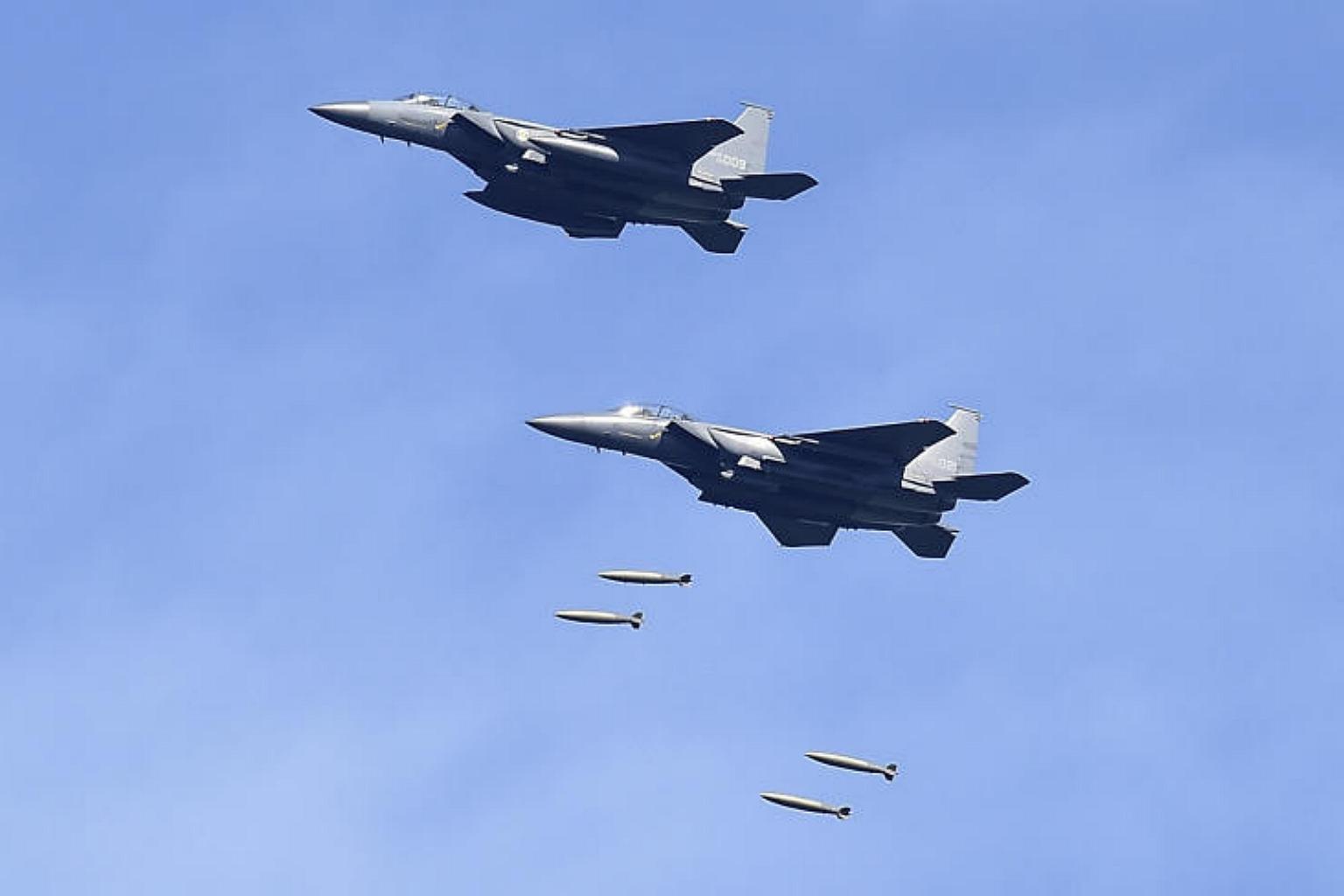US nuclear bombers, Japan and South Korea fighter jets stage show of force days after Pyongyang launched missile
Sign up now: Get insights on Asia's fast-moving developments

An undated handout photo of F-15K fighter jets with the South Korean military dropping bombs during training at a firing range in South Korea, on Aug 29, 2017.
PHOTO: NYT
Follow topic:
TOKYO/SEOUL (AFP, REUTERS) - Japanese and South Korean fighter jets on Thursday (Aug 31) conducted separate drills with US nuclear-capable bombers and F-35 stealth fighters in skies south of the Korean peninsula, two days after North Korea launched a ballistic missile over northern Japan.
The exercise around Japan's southern island of Kyushu involved two US Air Force B-1B Lancer bombers flying from Andersen Air Force Base on the US Pacific island territory of Guam and four F-35B stealth jets from the Iwakuni US Marine Corp Air Station in Japan.
They were joined by two Japanese F-15 jet fighters, Japan's Air Self Defence Force (ASDF) said in a news release.
The US aircraft went on to conduct live fire drills with South Korean military jets, the Japanese air force said.
North Korea this week fired a new strategic ballistic missile called the Hwasong-12 over northern Japan that reached an altitude of 550km (341.75 miles) before splashing down in the Pacific Ocean.
Thursday's exercise with the US is intended as a show of force against the North after its latest missile launch, Seoul said.
"South Korean and US air forces conducted an air interdiction exercise in order to strongly cope with North Korea's repeated firing of ballistic missiles and development of nuclear weapons," the South's air force said in a statement.
B-1B overflights of the peninsula from Guam, a US territory in the Pacific, infuriate the North, which cited them when it announced a plan to fire a salvo of missiles towards the island. It was one of the moves that saw tensions spiral this month, including a new set of UN Security Council sanctions, US President Donald Trump's apocalyptic warning to rain "fire and fury" on Pyongyang, and culminated with the North firing a missile over Japan on Tuesday.
China Thursday condemned "destructive" calls for further sanctions, warning Japan, the US and Britain that diplomacy was needed to avert a crisis. Foreign ministry spokeswoman Hua Chunying said sanctions alone "cannot fundamentally resolve the issue", amid reports the three countries were pushing for new restrictions on North Korean oil imports and foreign workers.
"The current situation on the Korean peninsula is not a screenplay, it's not a computer game. It is a real situation that directly bears on the security of the people on the peninsula and the whole regional peace and tranquility," she said.
On a visit to Japan Thursday, British Prime Minister Theresa May said London and Tokyo would work together to pressure North Korea "including by increasing the pace of sanctions" against Pyongyang".
Frustrated Trump
The UN Security Council has already imposed seven sets of sanctions on Pyongyang, the most recent of which were passed earlier this month, but the measures have done little to quell Kim Jong-Un's nuclear missile ambitions. In response to the latest missile launch, a frustrated Trump took to Twitter to condemn Pyongyang, saying "the US has been talking to North Korea, and paying them extortion money, for 25 years. Talking is not the answer!"
Thursday's live fire drill took place at the Pilseung shooting range in Gangwon province, some 150 kilometres (94 miles) south of the Demilitarized Zone dividing the two Koreas. A South Korean air force spokesman said it was separate from the annual Ulchi Freedom Guardian (UFG) joint exercises, which wrapped up on Thursday.
Tens of thousands of South Korean and US troops took part in the largely computer-simulated exercise that ran for two weeks in the South. The annual drills are viewed by nuclear-armed Pyongyang as a highly provocative rehearsal for invasion, and it always meets them with threats of strong military counteraction.
A US Forces Korea official told the Yonhap news agency that Washington had avoided sending bombers to Korea during the UFG exercises "in hopes that the reduced scale would send a positive signal to North Korea and the region", but Pyongyang had responded with a series of provocations.
The North's state media called Tuesday's Hwasong-12 intermediate range missile flight over northern Japan "a part of the muscle-flexing" against the war games. Leader Kim Jong Un called for more launches into the Pacific, the KCNA news agency said.
North Korea says it needs nuclear weapons to protect itself against the US and analysts say Pyongyang has made rapid strides in its ballistic technology in defiance of seven sets of United Nations resolutions. In July it conducted two successful ICBM launches which appeared to bring most of the US mainland into range.

